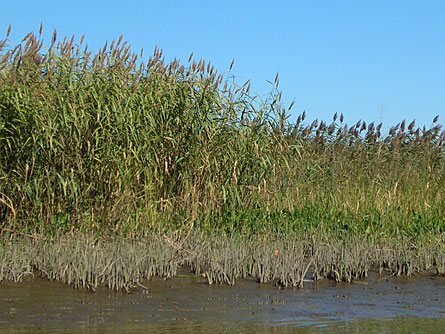Researchers convened July 25-29 at the Botany & Mycology 2009 meeting in Snowbird, Utah. Presented work included updates on some not-so-welcome plant visitors and a bat-plaguing fungus menace.
NOD-FOR-ME POTION
Tree of heaven outsources some of its nutrient-gathering efforts
SNOWBIRD, Utah — A notorious invader called the tree of heaven may have an unusual way of outsourcing some of its nutrient-finding efforts.
Ailanthus altissima trees, like most plants, can’t process nitrogen from the air into a usable form, but with help, clovers and many other legumes can. Bacteria housed in root nodules snag some of the abundant nitrogen in the air and convert it to a form that plants and other living things can use.
Research now shows that trees of heaven exude a substance that revs up the roots of clover plants to form these nodules, Jesse Lincoln of Grand Valley State University in Allendale, Mich., reported July 27 at the Botany & Mycology 2009 meeting. Clover nodules eventually enrich the soil with more user-friendly nitrogen. This trick for enhancing local nitrogen may explain in part how trees of heaven thrive in some pitiful soils, suggests coauthor Gary Greer, also of Grand Valley.
Greer and colleagues have been exploring the idea that some exudate might stimulate nodulation and had found evidence that some legumes form extra nodules when planted near trees of heaven. But previous work couldn’t rule out the possibility that the legumes formed extra nodules to get more nitrogen because trees of heaven were sucking the nutrient from the soil.
To see what triggers the nodules, Lincoln ran water through the soil in pots where trees of heaven grew and used the runoff to water potted clover plants. He added fertilizer to the clovers so that skimpy nitrogen concentrations would not stimulate nodulation. Plants exposed to tree of heaven runoff were twice as likely to form root nodules as those with no exposure. As far as he knows, Lincoln said, this is the first demonstration of one plant stimulating nodule formation in another. — Susan Milius

EACH OTHER ON
Study finds genetic diversity can contribute to the invasive’s spread
SNOWBIRD, Utah — Patches of common reed may explode into world-domination mode with a little help from their friends. An imported form of Phragmites australis can sit around wetlands without doing much harm but then suddenly spread relentlessly. Across North America, this alien form is choking out the daintier native plant of the same species, as well as the rest of the already dwindling wetland plant communities. New work suggests that the invader spreads more quickly when genetically diverse neighbors of the same species move in, Karin Kettenring of Utah State University in Logan reported July 27 at the Botany & Mycology 2009 meeting. In test patches, reed flowers fertilized with a mix of pollen from three genetically different reeds yielded 10 times as many viable seeds as did self-fertilized plants.
The results, from Phragmites grown at the Smithsonian Environmental Research Center in Edgewater, Md., on the Chesapeake Bay, illuminate a new factor in the ongoing reed invasion. As human activity disturbs wetlands, reed seeds find new patches to colonize. The first reed to arrive may not present much of a menace. But as other seeds arrive and grow up to produce their own blooms, cross-fertilization kicks seed production to a new level, Kettenring said. This increase amplifies the effects of other known boosters, such as fertilizer runoff, and there goes the neighborhood. — Susan Milius
WHITE-NOSE FUNGUS GETS A NAME
New research further elucidates bat-infecting fungus
SNOWBIRD, Utah— A fungus linked to bat die-offs has been named as a species new to science and has now been found on two continents, according to an update on the menace.
In what’s known as white-nose syndrome, the fungus forms white patches on the noses and other exposed skin of hibernating bats. The moldy bats emerge from their winter shelters ahead of the normal schedule and die emaciated, as if they were starving.
The nose mold genetically resembles fungi in the genus Geomyces, mycologist Andrea Gargas reported July 28. And this threat to bats hibernating in winter thrives in cool temperatures, just as other genus members that attack frozen food do, said Gargas, of Symbiology, a private research firm in Middleton, Wisc. Yet no other Geomyces species forms one-celled spores shaped like bananas. Based on these and other characteristics, Gargas and her colleagues named the species G. destructans, formalizing the nomenclaturein the April – June Mycotaxon.
White-nose syndrome first came to scientific notice after whole colonies of bats began dying off in New England. Now the fungus ranges from Canada south to Virginia, Gargas said. Genetic evidence confirms the fungus in Europe, though there have not been reports of widespread die-offs there, she said. — Susan Milius






